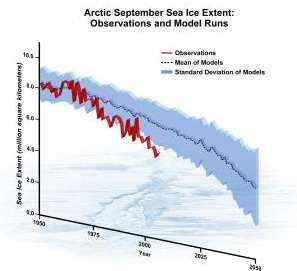October 27, 2014 report
Simulations show Eurasia more than twice as likely to have harsh winters due to sea ice melting

(Phys.org) —A team of researchers in Japan has found that Eurasia is twice as likely to experience severe winters over the next several decades because of melting Arctic sea ice. In their paper published in the journal Nature Geoscience, the researchers describe how they put together their computer model and why they believe that the harsher winters will only be temporary.
Prior studies have suggested that as the planet heats up due to global warming, the amount of sea ice in the Arctic decreases (due to warming water). In this new effort the researchers built computer simulations to model conditions over the past several decades, based on two separate scenarios—when ice levels were high, and when they were low. They then ran approximately 200 different simulations designed to forecast general weather trends over the next few decades for Europe and Asia using what was learned in the original modeling—they varied environmental factors and then watched what the simulations produced. Their simulations showed, they report, that the decline of sea ice in the Arctic Barents and Kara seas led to what they describe as blocking incidents—atmospheric circulation patterns—that led to colder air being pushed from the Arctic towards Eurasia which would quite naturally lead to harsher winters in that part of the world—twice as often as occurs now. They note that their findings agree with real-world weather data that has shown that Eurasia has been experiencing harsher winters in recent years.
The team notes that despite the apparent respite in global warming, changes continue unabated in the Arctic, as ice continues to melt. Prior research has suggested that the reason global warming has "paused" is because the ocean has been absorbing the excess heat. Increased heat in the atmosphere, in conjunction with smaller amounts of ice, they claim, will weaken high level winds that are part of the solar vortex which can cause changes to the jet stream which in turn can cause significant changes in winter temperatures across the northern hemisphere.

The researchers don't believe the harsher winters will continue forever, however, as their models suggest that as global warming reaches a certain point, the higher temperatures will eventually override the impact of colder air moving into Eurasia.
More information: Robust Arctic sea-ice influence on the frequent Eurasian cold winters in past decades, Nature Geoscience (2014) DOI: 10.1038/ngeo2277
Abstract
Over the past decade, severe winters occurred frequently in mid-latitude Eurasia, despite increasing global- and annual-mean surface air temperatures. Observations suggest that these cold Eurasian winters could have been instigated by Arctic sea-ice decline, through excitation of circulation anomalies similar to the Arctic Oscillation. In climate simulations, however, a robust atmospheric response to sea-ice decline has not been found, perhaps owing to energetic internal fluctuations in the atmospheric circulation6. Here we use a 100-member ensemble of simulations with an atmospheric general circulation model driven by observation-based sea-ice concentration anomalies to show that as a result of sea-ice reduction in the Barents–Kara Sea, the probability of severe winters has more than doubled in central Eurasia. In our simulations, the atmospheric response to sea-ice decline is approximately independent of the Arctic Oscillation. Both reanalysis data and our simulations suggest that sea-ice decline leads to more frequent Eurasian blocking situations, which in turn favour cold-air advection to Eurasia and hence severe winters. Based on a further analysis of simulations from 22 climate models we conclude that the sea-ice-driven cold winters are unlikely to dominate in a warming future climate, although uncertainty remains, due in part to an insufficient ensemble size.
Journal information: Nature Geoscience
© 2014 Phys.org



















